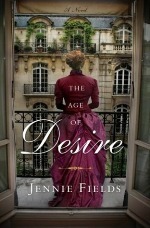A short review of Jennie Fields' The Age of Desire
 August is here at last! Over the last few months, I've been busy reviewing eight historical novels scheduled to come out in August. While I don't often repost previously published material, I want to highlight some of these books here as their publication dates roll by—including Jennie Fields' new novel The Age of Desire, literary biographical fiction about Edith Wharton's mid-life love affair, and how it affected her relationship with her closest friend.
August is here at last! Over the last few months, I've been busy reviewing eight historical novels scheduled to come out in August. While I don't often repost previously published material, I want to highlight some of these books here as their publication dates roll by—including Jennie Fields' new novel The Age of Desire, literary biographical fiction about Edith Wharton's mid-life love affair, and how it affected her relationship with her closest friend.The reviews I write for Booklist are exercises in concise writing. I have a limit of 175-200 words!
Edith Wharton lived in the glittering world of the moneyed elite she wrote about, although she never experienced her characters’ lustful motivations herself until she met American journalist Morton Fullerton. Fields bases her perceptive novel on Wharton’s own diaries and letters. By 1907, Edith is tired of husband Teddy’s gaucheness and depressive episodes and succumbs to the charms of Fullerton, whom she encounters at a French dinner party. It’s hard not to pity her—he is obviously a cad—but she displays a touching vulnerability, opening herself to passion for the first time at 45, and her anguish at Fullerton’s inconstancy is deeply felt. Readers also observe them from the viewpoint of Anna Bahlmann, the literary secretary and longtime friend Edith sometimes carelessly takes for granted. Gentle Anna doesn’t approve of the affair, which drives her and Edith apart for a time. While the novel concentrates more on the emotional than the intellectual sphere, it sheds welcome light on the little-known private life of a famous woman and her closest relationships in early-twentieth-century Europe and America.
For two more (slightly longer) takes on the novel, see the Historical Novels Review and Unabridged Chick.
The Age of Desire is published in August 2012 by Pamela Dorman/Viking in hardcover (352pp, $27.95). In the UK, the publisher is Ebury Press. My review first published in Booklist's July 2012 issue; reprinted with permission.
Published on August 02, 2012 16:59
No comments have been added yet.



